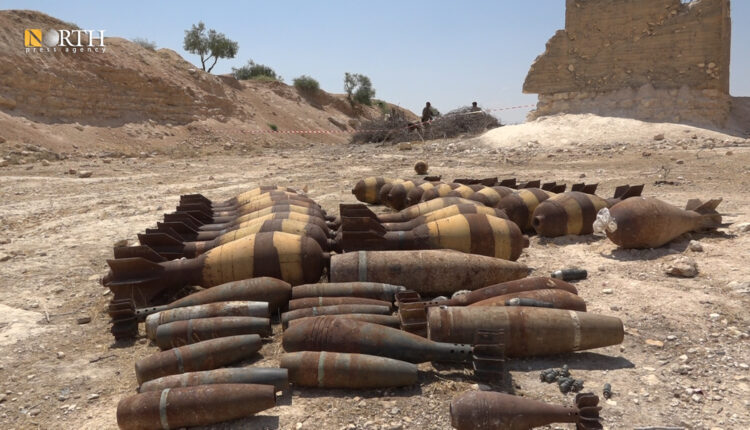War Remnants Kill Civilian, Injure Children in Northwest Syria
By Kardo Roj
IDLIB, Syria (North Press) – A civilian was killed and five others, including four children, were injured on Tuesday in two separate explosions caused by remnants of war in rural areas of Idlib governorate, underscoring the persistent humanitarian risks facing civilians in northwest Syria.
According to the Syrian Civil Defense (White Helmets), the first incident occurred in the village of Abu Dafna, located in the eastern countryside of Maarrat al-Numan. Two men were reportedly cleaning an abandoned well when one of them inadvertently triggered a landmine buried among unexploded ordnance, resulting in his death and the injury of his companion.
Later the same day, a second explosion took place on the outskirts of Maarrat al-Numan city, where a landmine detonated in a residential neighborhood, wounding four children from the same family. All were transferred to a local hospital for medical care. Medical personnel described some injuries as critical.
Explosive remnants of war (ERW) remain a pervasive danger across Syria, particularly in regions that have witnessed intense ground fighting or aerial bombardment over the past decade. The proliferation of mines, cluster munitions, and other unexploded devices has created long-term risks for returnees, agricultural workers, and children who often stumble upon these hazards unknowingly.
Human rights organizations and demining experts have repeatedly warned that the lack of a coordinated national demining strategy—particularly in non-government-held areas—continues to leave communities vulnerable.
In areas controlled by various opposition and Islamist factions, including those aligned with Hayat Tahrir al-Sham (HTS), civilian infrastructure and public safety measures remain under strain, with no central authority coordinating clearance operations.
While the Syrian Democratic Forces (SDF), with international assistance, have made progress in demining parts of northeast Syria, particularly following the defeat of ISIS in areas like Raqqa and Deir ez-Zor, northwest Syria remains largely outside the reach of such structured efforts.
The Autonomous Administration of North and East Syria (AANES) continues to emphasize the importance of sustained demining and community education programs in its regions, viewing them as vital to post-conflict recovery and the safe return of displaced persons.
By contrast, in Idlib and its surroundings—an area influenced by factions not party to national or international mine action programs—the absence of a clear security and governance framework has allowed the problem to persist and escalate.
The United Nations Office for the Coordination of Humanitarian Affairs (OCHA) has consistently appealed for increased funding for mine action across Syria. However, access constraints, fragmentation of territorial control, and donor fatigue have hindered progress.
As Syria remains divided among multiple actors, the lack of centralized mine clearance leaves communities in volatile regions like Idlib at heightened risk. Without broader cooperation and the establishment of locally rooted safety mechanisms, incidents like Tuesday’s are likely to recur.
Efforts to mitigate the threat of war remnants must be prioritized as part of any comprehensive approach to stabilizing Syria’s post-conflict landscape. Enhanced coordination between local actors, such as municipalities, civil society, and health agencies, remains crucial in preventing further civilian casualties.

